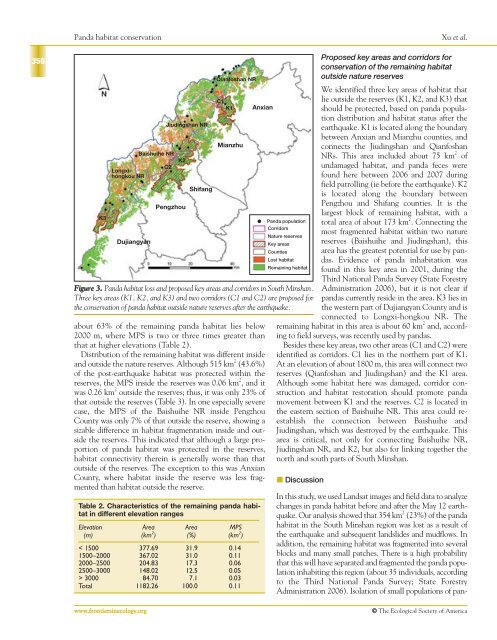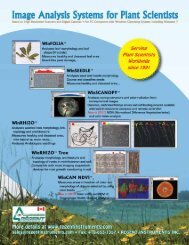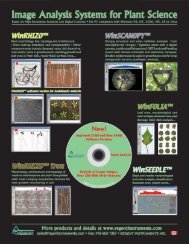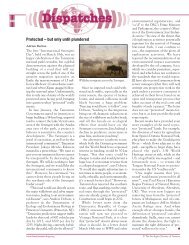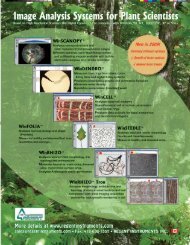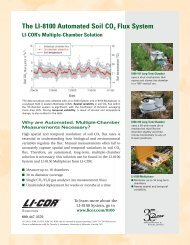Conservation of giant panda habitat in South Minshan, China, after ...
Conservation of giant panda habitat in South Minshan, China, after ...
Conservation of giant panda habitat in South Minshan, China, after ...
Create successful ePaper yourself
Turn your PDF publications into a flip-book with our unique Google optimized e-Paper software.
Panda <strong>habitat</strong> conservationXu et al.356K3LongxihongkouNRDujiangyanBaishuihe NRJiud<strong>in</strong>gshan NRFigure 3. Panda <strong>habitat</strong> loss and proposed key areas and corridors <strong>in</strong> <strong>South</strong> M<strong>in</strong>shan.Three key areas (K1, K2, and K3) and two corridors (C1 and C2) are proposed forthe conservation <strong>of</strong> <strong>panda</strong> <strong>habitat</strong> outside nature reserves <strong>after</strong> the earthquake.about 63% <strong>of</strong> the rema<strong>in</strong><strong>in</strong>g <strong>panda</strong> <strong>habitat</strong> lies below2000 m, where MPS is two or three times greater thanthat at higher elevations (Table 2).Distribution <strong>of</strong> the rema<strong>in</strong><strong>in</strong>g <strong>habitat</strong> was different <strong>in</strong>sideand outside the nature reserves. Although 515 km 2 (43.6%)<strong>of</strong> the post-earthquake <strong>habitat</strong> was protected with<strong>in</strong> thereserves, the MPS <strong>in</strong>side the reserves was 0.06 km 2 , and itwas 0.26 km 2 outside the reserves; thus, it was only 23% <strong>of</strong>that outside the reserves (Table 3). In one especially severecase, the MPS <strong>of</strong> the Baishuihe NR <strong>in</strong>side PengzhouCounty was only 7% <strong>of</strong> that outside the reserve, show<strong>in</strong>g asizable difference <strong>in</strong> <strong>habitat</strong> fragmentation <strong>in</strong>side and outsidethe reserves. This <strong>in</strong>dicated that although a large proportion<strong>of</strong> <strong>panda</strong> <strong>habitat</strong> was protected <strong>in</strong> the reserves,<strong>habitat</strong> connectivity there<strong>in</strong> is generally worse than thatoutside <strong>of</strong> the reserves. The exception to this was AnxianCounty, where <strong>habitat</strong> <strong>in</strong>side the reserve was less fragmentedthan <strong>habitat</strong> outside the reserve.Table 2. Characteristics <strong>of</strong> the rema<strong>in</strong><strong>in</strong>g <strong>panda</strong> <strong>habitat</strong><strong>in</strong> different elevation rangesElevation Area Area MPS(m) (km 2 ) (%) (km 2 )< 1500 377.69 31.9 0.141500–2000 367.02 31.0 0.112000–2500 204.83 17.3 0.062500–3000 148.02 12.5 0.05> 3000 84.70 7.1 0.03Total 1182.26 100.0 0.11C2K2PengzhouShifangQianfoshan NRC1K1MianzhuAnxianProposed key areas and corridors forconservation <strong>of</strong> the rema<strong>in</strong><strong>in</strong>g <strong>habitat</strong>outside nature reservesWe identified three key areas <strong>of</strong> <strong>habitat</strong> thatlie outside the reserves (K1, K2, and K3) thatshould be protected, based on <strong>panda</strong> populationdistribution and <strong>habitat</strong> status <strong>after</strong> theearthquake. K1 is located along the boundarybetween Anxian and Mianzhu counties, andconnects the Jiud<strong>in</strong>gshan and QianfoshanNRs. This area <strong>in</strong>cluded about 75 km 2 <strong>of</strong>undamaged <strong>habitat</strong>, and <strong>panda</strong> feces werefound here between 2006 and 2007 dur<strong>in</strong>gfield patroll<strong>in</strong>g (ie before the earthquake). K2is located along the boundary betweenPengzhou and Shifang counties. It is thelargest block <strong>of</strong> rema<strong>in</strong><strong>in</strong>g <strong>habitat</strong>, with atotal area <strong>of</strong> about 173 km 2 . Connect<strong>in</strong>g themost fragmented <strong>habitat</strong> with<strong>in</strong> two naturereserves (Baishuihe and Jiud<strong>in</strong>gshan), thisarea has the greatest potential for use by <strong>panda</strong>s.Evidence <strong>of</strong> <strong>panda</strong> <strong>in</strong><strong>habitat</strong>ion wasfound <strong>in</strong> this key area <strong>in</strong> 2001, dur<strong>in</strong>g theThird National Panda Survey (State ForestryAdm<strong>in</strong>istration 2006), but it is not clear if<strong>panda</strong>s currently reside <strong>in</strong> the area. K3 lies <strong>in</strong>the western part <strong>of</strong> Dujiangyan County and isconnected to Longxi-hongkou NR. Therema<strong>in</strong><strong>in</strong>g <strong>habitat</strong> <strong>in</strong> this area is about 60 km 2 and, accord<strong>in</strong>gto field surveys, was recently used by <strong>panda</strong>s.Besides these key areas, two other areas (C1 and C2) wereidentified as corridors. C1 lies <strong>in</strong> the northern part <strong>of</strong> K1.At an elevation <strong>of</strong> about 1800 m, this area will connect tworeserves (Qianfoshan and Jiud<strong>in</strong>gshan) and the K1 area.Although some <strong>habitat</strong> here was damaged, corridor constructionand <strong>habitat</strong> restoration should promote <strong>panda</strong>movement between K1 and the reserves. C2 is located <strong>in</strong>the eastern section <strong>of</strong> Baishuihe NR. This area could reestablishthe connection between Baishuihe andJiud<strong>in</strong>gshan, which was destroyed by the earthquake. Thisarea is critical, not only for connect<strong>in</strong>g Baishuihe NR,Jiud<strong>in</strong>gshan NR, and K2, but also for l<strong>in</strong>k<strong>in</strong>g together thenorth and south parts <strong>of</strong> <strong>South</strong> M<strong>in</strong>shan.Panda populationCorridorsNature reservesKey areasCountiesLost <strong>habitat</strong>Rema<strong>in</strong><strong>in</strong>g <strong>habitat</strong> DiscussionIn this study, we used Landsat images and field data to analyzechanges <strong>in</strong> <strong>panda</strong> <strong>habitat</strong> before and <strong>after</strong> the May 12 earthquake.Our analysis showed that 354 km 2 (23%) <strong>of</strong> the <strong>panda</strong><strong>habitat</strong> <strong>in</strong> the <strong>South</strong> M<strong>in</strong>shan region was lost as a result <strong>of</strong>the earthquake and subsequent landslides and mudflows. Inaddition, the rema<strong>in</strong><strong>in</strong>g <strong>habitat</strong> was fragmented <strong>in</strong>to severalblocks and many small patches. There is a high probabilitythat this will have separated and fragmented the <strong>panda</strong> population<strong>in</strong>habit<strong>in</strong>g this region (about 35 <strong>in</strong>dividuals, accord<strong>in</strong>gto the Third National Panda Survey; State ForestryAdm<strong>in</strong>istration 2006). Isolation <strong>of</strong> small populations <strong>of</strong> pan-www.frontiers<strong>in</strong>ecology.org© The Ecological Society <strong>of</strong> America


